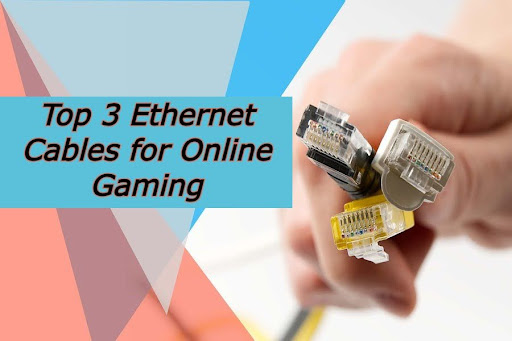For any online gamer, victory and defeat differ by just milliseconds. To this end, one needs to have a reliable network. Of course, one of the major parts of this setup would be an Ethernet cable, which does the job of physically transferring data from your gaming device to your ISP.
This all-inclusive guide will go through each aspect of Ethernet cables and underline the three best options working best for online gaming: Cat5e, Cat6a, and Cat6 Ethernet cable. Each option will contain many advantages alongside considerations that will have to be taken into account. In this way, you’ll understand the difference each version has, teaching you how to make your decision based on needs and budget.
Understanding Ethernet Cables
Nevertheless, before several Ethernet networking cables are delved into, let me just focus on the more basic levels of understanding about what really makes up an Ethernet cable. An Ethernet cable is essentially, in its very basic understanding, twisted pairs of copper wires within an outer sheath. The real difference in bandwidth capacity and the speed of transmission are categorized by the number of twisted pairs, quality of the wire used, and the type of shielding used in the construction.
Cat5e Ethernet Cable: Cost-Effective Variant
Out of all the cables that can be used for home and small office networking, Cat5e is by far the most in use. It is an inexpensive, quite reliable option. Cat5e offers decent data transmission speedss of up to 100 Mbps over 100 meters. This is more than enough for most casual gaming experiences online.
While Cat5e isn’t really the best solution for high-intensity gaming that’s going to give maximum bang for the buck in bandwidth, it still gives quite a good base for those on a tight budget.
Key Features and Considerations
- Speed: Supports 100 Mbps of data transfer rates
- Affordability: Generally the cheapest option available
- Compatibility: Quite well-matched to different networking devices
- Limitations: Maybe inadequate for strenuous gaming apps or high-resolution video streaming
Pros
Affordability: The Cat5e cables are generally the cheapest option, making them quite appropriate if you are on a budget.
Compatibility: Widely compatible with various network devices, thus making sure that most routers, modems, and even game consoles are compatible.
Reliability: These cables offer good performance for general internet applications and casual gaming.
Cons
Low Bandwidth: The 100 Mbps data transfer speed is not fit for heavy games or streams with higher resolution.
Future-Proofing: Cat5e cables are not a great way to future-proof your network because newer standards offer significantly more bandwidth.
Cat6 Ethernet Cable: A Balanced Choice
The Cat6 Ethernet cable definitely is a step up compared to Cat5e. Its performance and bandwidth capacity is significantly higher. The most popular Category 6 ethernet cable for gaming is the Cat6 Plenum Cable which supports data speeds of up to 1 Gbps. This cable provides a better, more reliable connection where gamers need it most. Cat6 Ethernet Cables lower crosstalk and interference, thereby ensuring the stable transmission of data in hostile environments.
Key Features and Considerations
- Speed: 1 Gbps data transfer rates are supported.
- Performance: Added bandwidth improves performance while reducing interference.
- Compatibility: It is compatible with 100 Mbps and 1 Gbps applications and networks.
- Cost: Cat6 is pricier than Cat5e but still affordable.
Pros:
Improved Bandwidth: The Cat6 cables do present the much-needed boost over the Cat5e cables in supporting 1 Gbps data transfer speeds for those myriad applications that need more bandwidth, as in the case of online gaming.
Less Interference: Cat 6 cables, as compared to previous cable types, have been manufactured in a fashion that tries to minimize crosstalk or interference. As such, stable data transmission remains even in the most challenging environments.
Compatibility: Workable for both 100 Mbps and 1 Gbps networks; flexibility in a number of different network configurations is allowed
Cons:
Cost: The Cat6 cables cost more than the Cat5e but are rather cheap as compared to Cat6a.
Performance: While Cat6 makes some serious improvements over Cat5e, it won’t be suitable for those seeking to attain the highest performance and future-proofing.
The Cat6a Ethernet Cable: For the Pro Gamer
The Cat6a augmented category Ethernet cable is what gamers would use if they wanted really to take advantage of things in both quality and future-proofing. It provides excellent bandwidth capacity while attaining data transfer speeds of up to 10 Gbps.
Cat6a employs enhanced shielding and twisted-pair technology to reduce crosstalk and ensure the highest level of signal integrity. It is, however, the most expensive option. For this reason, users of Cat6a cables would include those looking for the highest level of performance possible and wanting to pay a premium for that.
Features and key considerations:
- Speed: Supports data transfer rates of 10Gbps
- Performance: Higher quality signals with less interference
- Compatibility: 100 Mbps, 1 Gbps, and 10 Gbps networks
- Cost: Most expensive, but highest performance rating
Pros:
Best Performance: The Cat6a cable has exceptional bandwidth capabilities that could ensure a speed of 10 Gbps for demanding applications, thus future-proofing your network.
Signal Integrity: Using advanced shielding and twisted pair technology to minimize crosstalk, it also delivers maximum signal integrity.
Compatibility: The cables are compatible with 100 Mbps, 1 Gbps, and 10 Gbps, thus versatile for various network configurations.
Cons:
Cost: Cat6a cables are the costliest, hence a very serious investment for people seeking the highest levels of performance.
Overkill: If one does not use the full capabilities given by 10 Gbps, then Cat6a would be overkill.
Choosing the Right Ethernet Cable for Your Gaming Needs
Gaming Requirements: In the case of light gaming, with a basic set of games—casual play only—Cat5e would be sufficient. For high-end games that require fast bandwidth, heavy graphics, and online multiplayer features, one would use Cat6 and Cat6a.
Budget: Cat5e is the cheapest, followed by Cat6 and then Cat6a. Consider your wallet and decide how much you can afford to spend.
Future Proofing: If one wants to future-proof the network and be ready for upcoming technologies, then Cat6a cable is the way to go. It provides enough bandwidth for applications that are going to be future-proof.
Cable Length: The length of the Ethernet cable also determines its performance. More length might diminish the signal. It is always better to try and use shorter cables whenever possible.
Additional Considerations
Cable Quality: The quality of the Ethernet cable is a concern. Watch for the certification from organizations like TIA, and the Telecommunications Industry Association. The certified cables would have cleared tests to meet some standards and assure performance.
Shielding: Shielded bulk ethernet cables have an extra layer of protection against electromagnetic interference, especially on signals. If this is the case concerning interference, then use a shielded cable.
In a Nutshell
All of these factors considered, a gamer using the right Ethernet cable will eventually improve the online gaming experience and reduce the frustrating interruptions in network connectivity. Happy Gaming!

